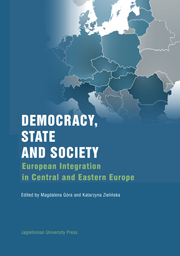Book contents
- Frontmatter
- Contents
- List of contributors
- Europeanisation in the EU New Member States. Aspects and Research Agendas
- Part one Democracy after Enlargement
- Part two Identity Transformations
- The Identity of Europeans after the EU Enlargement
- Peripheries and Borders in a Post-Western Europe
- Between Reconciliation and the Reactivation of Past Conflicts in Europe: Rethinking Social Memory Paradigms
- How Different is the “New Europe”? Perspectives on States and Minorities
- Part three Civil Society Organisations in Central and Eastern Europe
- Part four Europeanisation of International Relations
- Index
The Identity of Europeans after the EU Enlargement
from Part two - Identity Transformations
Published online by Cambridge University Press: 05 September 2014
- Frontmatter
- Contents
- List of contributors
- Europeanisation in the EU New Member States. Aspects and Research Agendas
- Part one Democracy after Enlargement
- Part two Identity Transformations
- The Identity of Europeans after the EU Enlargement
- Peripheries and Borders in a Post-Western Europe
- Between Reconciliation and the Reactivation of Past Conflicts in Europe: Rethinking Social Memory Paradigms
- How Different is the “New Europe”? Perspectives on States and Minorities
- Part three Civil Society Organisations in Central and Eastern Europe
- Part four Europeanisation of International Relations
- Index
Summary
The enlargement of the European Union in 2004–2007 changed the borders of the polity, but also contributed to a crisis of the collective identity of Europeans. The inclusion of many new countries in the EU, relatively little known to the Western European public, generated questions concerning the common European framework of cultural heritage and way of life. Where are the borders of Europe, who is a European, and who is “the significant other” for the Europeans – that is, in relation to whom will Europeans construct their identity? These are the major questions occupying thoughts of scholars, intellectuals and public opinion in Europe and also are the main topic of our interest in this part of the volume.
Both “old” and “new” Europeans are experiencing an identity crisis. The citizens of the old 15 EU member states were confronted with enlargement without having been directly consulted, and without having had the chance to learn enough about the new members to accept them as “us” rather than “them” from behind the Iron Curtain. There is no clear concept of Eastern Europeans belonging to the community of Europeans, and frequent news in the media concerning the political behaviour of the Eastern Europeans or the lack of acceptance of crucial European values (such as tolerance, the secular state, the rule of law) has strengthened the feeling that the east of Europe is still divided from the west by a boundary of culture.
- Type
- Chapter
- Information
- Democracy, State and SocietyEuropean Integration in Central and Eastern Europe, pp. 107 - 112Publisher: Jagiellonian University PressPrint publication year: 2011



